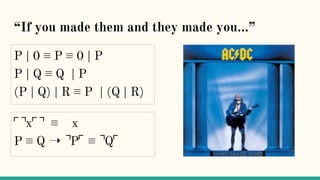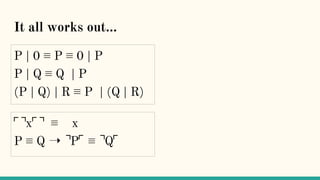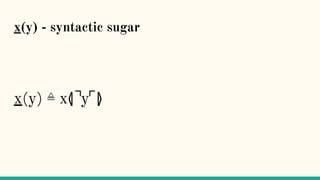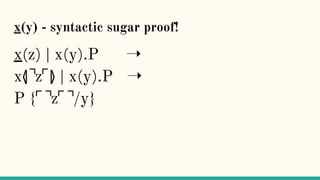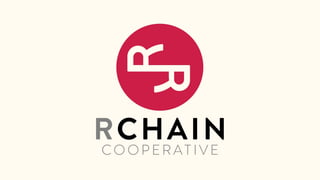Understanding distributed calculi in Haskell
- 1. Understanding Distributed Calculi in Haskell Pawel Szulc @rabbitonweb
- 5. Understanding Distributed Calculi in Haskell Pawel Szulc @rabbitonweb
- 6. Haskell
- 27. distributed-process also known as Cloud Haskell
- 31. distributed-process data Process a ProcessId send :: Serializable a => ProcessId -> a -> Process ()
- 32. distributed-process data Process a ProcessId expect :: forall a. Serializable a => Process a send :: Serializable a => ProcessId -> a -> Process ()
- 34. master
- 35. master ping pong
- 36. master ping pong
- 38. master ping pong
- 40. master ping pong
- 42. master ping
- 43. master ping Done
- 44. master
- 67. Calculus!
- 68. λ-calculus
- 69. Syntax L, M, N :: = x variable λx.M abstraction M N application
- 72. Few definitions λx.λy.(x y x) ≡ λz.λw.(z w z) alpha equivalence
- 73. Few definitions λx.λy.(x y x) ≡ λz.λw.(z w z) alpha equivalence
- 74. Few definitions λx.λy.(x y x) ≡ λz.λw.(z w z) alpha equivalence
- 75. Few definitions λx.M ≡ λy.M {y/x} alpha conversion
- 77. Few definitions λx.(x y) free variable
- 78. Beta reduction ● Applying argument to a function.
- 79. Beta reduction ● Applying argument to a function. ● Consider it as a single computation step.
- 80. Beta reduction (λx.N) M ➝ N{M/x}
- 81. Beta reduction - example
- 82. Beta reduction - example (λx.λy.x) z w
- 83. Beta reduction - example (λx.λy.x) z w ➝ (λy.z) w
- 84. Beta reduction - example (λx.λy.x) z w ➝ (λy.z) w ➝ z
- 85. Is that it? L, M, N :: = x λx.M M N (λx.N) M ➝ N{M/x}
- 86. Is that it? L, M, N :: = x λx.M M N (λx.N) M ➝ N{M/x}
- 87. Encodings
- 88. Encodings ● support for multi argument functions λ(x,y).M
- 89. Encodings ● support for multi argument functions λ(x,y).M ≡ λx.λy.M
- 90. Encodings ● support for multi argument functions ○ Moses Schönfinkel
- 91. Encodings ● support for multi argument functions ○ Haskell Curry
- 92. Encodings ● support for multi argument functions ● boolean values
- 93. Encodings ● support for multi argument functions ● boolean values True = λt.λf.t False = λt.λf.f
- 94. Encodings ● support for multi argument functions ● boolean values True = λt.λf.t False = λt.λf.f If = λl.λm.λn l m n And = λb.λc. b c False
- 95. Encodings ● support for multi argument functions ● boolean values ● Church numerals
- 96. Is there a calculus for distributed computing?
- 97. Is there a calculus for distributed computing? “The inevitability of the lambda-calculus arises from the fact that the only way to observe a functional computation is to watch which output values it yields when presented with different input values” [1]
- 98. Is there a calculus for distributed computing? “Unfortunately, the world of concurrent computation is not so orderly. Different notions of what can be observed may be appropriate in different circumstances, giving rise to different definitions of when two concurrent systems have ‘the same behavior’ ” [1]
- 99. CCS & CSP
- 100. CCS & CSP CCS - Calculus of Communicating Systems [3] CSP - Communicating Sequential Processes [4]
- 101. π-calculus
- 102. What is π-calculus “π -calculus is a model of computation for concurrent systems.” [2]
- 103. What is π-calculus “In lambda-calculus everything is a function (...) In the pi-calculus every expression denotes a process - a free-standing computational activity, running in parallel with other process.” [1]
- 104. What is π-calculus “Two processes can interact by exchanging a message on a channel” [1]
- 105. What is π-calculus “It lets you represent processes, parallel composition of processes, synchronous communication between processes through channels, creation of fresh channels, replication of processes, and nondeterminism.” [2]
- 106. Syntax P, Q, R :: = 0 inert process x(y).P input prefix xy.P output prefix P | Q parallel composition (νx)P restriction !P replication
- 107. Syntax P, Q, R :: = 0 inert process x(y).P input prefix xy.P output prefix P | Q parallel composition (νx)P restriction !P replication
- 108. Syntax P, Q, R :: = 0 inert process x(y).P input prefix xy.P output prefix P | Q parallel composition (νx)P restriction !P replication
- 109. Syntax P, Q, R :: = 0 inert process x(y).P input prefix xy.P output prefix P | Q parallel composition (νx)P restriction !P replication
- 110. Input and output example Model a program that runs single process P, which sends message hello on channel x and then receives a message msg on the same channel x.
- 111. Input and output example P :: =x(hello).x(msg).0
- 112. Input and output example P :: = x(hello).x(msg).0 P
- 113. Input and output example P :: = x(hello).x(msg).0 P xhello
- 114. Input and output example P :: = x(hello).x(msg).0 P x hello
- 115. Input and output example P :: = x(hello).x(msg).0 P x hello
- 116. Input and output example P :: = x(hello).x(msg).0 P x hello
- 117. Input and output example P :: = x(hello).x(msg).0 P x hello
- 118. Input and output example P :: = x(hello).x(msg).0 P x msg
- 119. Input and output example P :: = x(hello).x(msg).0
- 120. Input and output example P :: = x(hello).x(msg).0
- 121. Input and output example P :: = x(hello).x(msg).0 P xhello
- 122. Input and output example P :: = x(hello).x(msg).0 P xhello Waits for message ‘msg’ on channel ‘x’, before continuing.
- 123. Input and output example P :: = x(hello).x(msg).0 P xhello This is a synchronous call. It waits until somebody receives it.
- 124. Syntax P, Q, R :: = 0 inert process x(y).P input prefix xy.P output prefix P | Q parallel composition (νx)P restriction !P replication
- 125. Syntax P, Q, R :: = 0 inert process x(y).P input prefix xy.P output prefix P | Q parallel composition (νx)P restriction !P replication
- 126. Syntax P, Q, R :: = 0 inert process x(y).P input prefix xy.P output prefix P | Q parallel composition (νx)P restriction !P replication
- 127. How to pronounce ν? lower-case: ν sound: Nee greek name: Νι
- 128. How to pronounce ν? lower-case: ν sound: Nee greek name: Νι
- 129. Syntax P, Q, R :: = 0 inert process x(y).P input prefix xy.P output prefix P | Q parallel composition (νx)P restriction !P replication
- 130. (νx)P restriction bounds a variable P ::= yx.0
- 131. (νx)P restriction bounds a variable P ::= yx.0 Q ::= (νx)P
- 132. (νx)P restriction bounds a variable P ::= yx.0 Q ::= (νx)P → (νx)(yx.0)
- 133. (νx)P restriction bounds a variable (νx)yx.0 == (νz)yz.0
- 134. Syntax P, Q, R :: = 0 inert process x(y).P input prefix xy.P output prefix P | Q parallel composition (νx)P restriction !P replication
- 135. Syntax P, Q, R :: = 0 inert process x(y).P input prefix xy.P output prefix P | Q parallel composition (νx)P restriction !P replication
- 136. Input and output example revisited P :: = x(hello).0 Q :: =x(msg).0 R :: = νx(P | Q).0
- 137. Input and output example revisited P :: = x(hello) Q :: =x(msg) R :: = νx(P | Q)
- 138. R Input and output example revisited P :: = x(hello) Q :: =x(msg) R :: = νx(P | Q)
- 139. R Input and output example revisited P :: = x(hello) Q :: =x(msg) R :: = νx(P | Q) P Q
- 140. R Input and output example revisited P :: = x(hello) Q :: =x(msg) R :: = νx(P | Q) P Qx
- 141. R Input and output example revisited P :: = x(hello) Q :: =x(msg) R :: = νx(P | Q) P Qx hello
- 142. R Input and output example revisited P :: = x(hello) Q :: =x(msg) R :: = νx(P | Q) P Qx hello
- 143. R Input and output example revisited P :: = x(hello) Q :: = x(msg) R :: = νx(P | Q) Q msg
- 144. R Input and output example revisited P :: = x(hello) Q :: = x(msg) R :: = νx(P | Q)
- 145. Input and output example revisited P :: = x(hello) Q :: = x(msg) R :: = νx(P | Q)
- 146. Syntax P, Q, R :: = 0 inert process x(y).P input prefix xy.P output prefix P | Q parallel composition (νx)P restriction !P replication
- 147. Syntax P, Q, R :: = 0 inert process x(y).P input prefix xy.P output prefix P | Q parallel composition (νx)P restriction !P replication
- 148. Structural Congruence “Two processes are structurally congruent, if they are identical up to structure.” [5]
- 149. Structural Congruence P | Q ≡ Q | P commutativity of parallel composition
- 150. Structural Congruence P | Q ≡ Q | P commutativity of parallel composition (P | Q) | R ≡ P | (Q | R) associativity of parallel composition
- 151. Structural Congruence P | Q ≡ Q | P commutativity of parallel composition (P | Q) | R ≡ P | (Q | R) associativity of parallel composition ((νx)P) | Q ≡ (νx)(P | Q) “scope extrusion”
- 152. Structural Congruence P | Q ≡ Q | P commutativity of parallel composition (P | Q) | R ≡ P | (Q | R) associativity of parallel composition ((νx)P) | Q ≡ (νx)(P | Q) “scope extrusion” !P ≡ P | !P replication
- 153. Structural Congruence P | Q ≡ Q | P commutativity of parallel composition (P | Q) | R ≡ P | (Q | R) associativity of parallel composition ((νx)P) | Q ≡ (νx)(P | Q) “scope extrusion” !P ≡ P | !P replication (νx)(νy)P ≡ (νy)(νx)P restriction
- 154. Reduction rules ⟶ Think of it as a operational semantics. P ⟶ P’ represents a single computation step
- 155. Reduction rules ⟶ xy.P | x(z).Q communication
- 156. Reduction rules ⟶ xy.P | x(z).Q communication
- 157. Reduction rules ⟶ xy.P | x(z).Q → P | [y/z]Q communication
- 158. Reduction rules ⟶ xy.P | x(z).Q → P | [y/z]Q communication P | R → if P → Q reduction under |
- 159. Reduction rules ⟶ xy.P | x(z).Q → P | [y/z]Q communication P | R → Q | R if P → Q reduction under |
- 160. Reduction rules ⟶ xy.P | x(z).Q → P | [y/z]Q communication P | R → Q | R if P → Q reduction under | (νx)P → if P → Q reduction under ν
- 161. Reduction rules ⟶ xy.P | x(z).Q → P | [y/z]Q communication P | R → Q | R if P → Q reduction under | (νx)P → (νx)Q if P → Q reduction under ν
- 162. Reduction rules ⟶ xy.P | x(z).Q → P | [y/z]Q communication P | R → Q | R if P → Q reduction under | (νx)P → (νx)Q if P → Q reduction under ν P → if P ≡ P’ Q’ ≡ Q structural congruence
- 163. Reduction rules ⟶ xy.P | x(z).Q → P | [y/z]Q communication P | R → Q | R if P → Q reduction under | (νx)P → (νx)Q if P → Q reduction under ν P → if P ≡ P’ → Q’ ≡ Q structural congruence
- 164. Reduction rules ⟶ xy.P | x(z).Q → P | [y/z]Q communication P | R → Q | R if P → Q reduction under | (νx)P → (νx)Q if P → Q reduction under ν P → Q if P ≡ P’ → Q’ ≡ Q structural congruence
- 165. Some examples(1) - PingPong PING ::= x(ping).x(pong) PONG ::= x(ping).x(pong) P ::= PING | PONG
- 166. Some examples(1) - PingPong PING ::= x(ping).x(pong) PONG ::= x(ping).x(pong) P ::= x(ping).x(pong) | x(ping).x(pong)
- 167. Some examples(1) - PingPong P ::= x(ping).x(pong) | x(ping).x(pong)
- 168. Some examples(1) - PingPong P ::= x(ping).x(pong) | x(ping).x(pong) xy.P | x(z).Q → P | [y/z]Q communication
- 169. Some examples(1) - PingPong P ::= x(ping).x(pong) | x(ping).x(pong) xy.P | x(z).Q → P | [y/z]Q communication
- 170. Some examples(1) - PingPong P ::= x(ping).x(pong) | x(ping).x(pong) xy.P | x(z).Q → P | [y/z]Q communication
- 171. Some examples(1) - PingPong P ::= x(pong) | x(pong) xy.P | x(z).Q → P | [y/z]Q communication
- 172. Some examples(1) - PingPong P ::= x(pong) | x(pong)
- 173. Some examples(1) - PingPong P ::= x(pong) | x(pong) xy.P | x(z).Q → P | [y/z]Q communication
- 174. Some examples(1) - PingPong P ::= x(pong) | x(pong) xy.P | x(z).Q → P | [y/z]Q communication
- 175. Some examples(1) - PingPong P ::= 0 | 0 xy.P | x(z).Q → P | [y/z]Q communication
- 176. Some examples(1) - PingPong P ::= 0 | 0
- 177. Some examples(1) - PingPong P ::= 0 | 0 P | 0 ≡ P missing equivalence?
- 180. Some examples(1) - PingPong P ::= 0 | 0 P | 0 ≡ P wikipedia equivalence
- 181. Some examples(1) - PingPong P ::= 0
- 182. Some examples(0) - Sending channels P ::= (νy)xy.yw.yz Q ::= x(y).y(h).y(h) R ::= (νx)(P | Q)
- 183. Some examples(0) - Sending channels P ::= (νy)xy.yw.yz Q ::= x(y).y(h).y(h) R ::= (νx)((νy)xy.yw.yz | x(y).y(h).y(h))
- 184. Some examples(0) - Sending channels P ::= (νy)xy.yw.yz Q ::= x(y).y(h).y(h) R ::= (νx)((νy)xy.yw.yz | x(y).y(h).y(h)) xy.P | x(z).Q → P | [y/z]Q communication
- 185. Some examples(0) - Sending channels P ::= (νy)xy.yw.yz Q ::= x(y).y(h).y(h) R ::= (νx)((νy)xy.yw.yz | x(y).y(h).y(h)) xy.P | x(z).Q → P | [y/z]Q communication
- 186. Some examples(0) - Sending channels P ::= (νy)xy.yw.yz Q ::= x(y).y(h).y(h) R ::= (νx)((νy)yw.yz | y(h).y(h)) xy.P | x(z).Q → P | [y/z]Q communication
- 187. Some examples(0) - Sending channels P ::= (νy)xy.yw.yz Q ::= x(y).y(h).y(h) R ::= (νx)((νy)yw.yz | y(h).y(h)) xy.P | x(z).Q → P | [y/z]Q communication
- 188. Some examples(0) - Sending channels P ::= (νy)xy.yw.yz Q ::= x(y).y(h).y(h) R ::= (νx)((νy)yz | y(h)) xy.P | x(z).Q → P | [y/z]Q communication
- 189. Some examples(0) - Sending channels P ::= (νy)xy.yw.yz Q ::= x(y).y(h).y(h) R ::= (νx)((νy) 0 | 0)
- 190. Some examples(0) - Sending channels P ::= (νy)xy.yw.yz Q ::= x(y).y(h).y(h) R ::= 0
- 191. Some examples(2) - PingPong PING ::= x(ping).x(pong) PONG ::= x(ping).x(pong) P ::= PING | PONG | PONG
- 192. Some examples(2) - PingPong P ::= PING | PONG | PONG
- 193. Some examples(2) - PingPong P ::= x(ping).x(pong) | x(ping).x(pong) | x(ping).x(pong)
- 194. Some examples(2) - PingPong P ::= x(ping).x(pong) | x(ping).x(pong) | x(ping).x(pong)
- 195. Some examples(2) - PingPong P ::= x(ping).x(pong) | x(ping).x(pong) | x(ping).x(pong)
- 196. Some examples(2) - PingPong P ::=x(pong) | x(ping).x(pong) |x(pong)
- 197. Some examples(2) - PingPong P ::=x(pong) | x(ping).x(pong) |x(pong)
- 198. Some examples(2) - PingPong P ::= 0 | x(ping).x(pong) | 0
- 199. Some examples(3) - PingPong PING ::= x(ping).x(pong) PONG ::= x(ping).x(pong) P ::= PING | PONG
- 200. Some examples(3) - PingPong PING ::= x(ping).x(pong) PONG ::= x(ping).x(pong) P ::= !PING | !PONG
- 201. Some examples(3) - PingPong P ::= !PING | !PONG
- 202. Some examples(3) - PingPong P ::= !PING | !PONG !P ≡ P | !P replication
- 203. Some examples(3) - PingPong P ::= PING | !PING | PONG | !PONG !P ≡ P | !P replication
- 204. Some examples(3) - PingPong P ::= PING | !PING | PONG | !PONG
- 205. Some examples(3) - PingPong P ::= 0 | !PING | 0 | !PONG
- 206. Some examples(3) - PingPong P ::= 0 | PING | !PING | 0 | PONG | !PONG
- 207. Some examples(3) - PingPong P ::= 0 | 0 | !PING | 0 | 0 | !PONG
- 208. Some examples(4) - Race Conditions P ::= xy | xz | x(w).w(v)
- 209. Some examples(4) - Race Conditions P ::= xy | xz | x(w).w(v)
- 210. Some examples(4) - Race Conditions P ::= xy | xz | x(w).w(v)
- 211. Some examples(4) - Race Conditions P ::= xy | xz | x(w).w(v)
- 212. Some examples(4) - Race Conditions P ::= xy | xz | x(w).w(v) P ::= 0 | xz | y(v)
- 213. Some examples(4) - Race Conditions P ::= xy | xz | x(w).w(v) P ::= 0 | xz | y(v) P ::= xy | 0 | z(v)
- 214. Some examples(4) - Race Conditions P ::= xy | xz | x(w).w(v) P ::= xz | y(v) P ::= xy | z(v)
- 215. Two processes P and Q are bisimilar if ... “Two processes P and Q are bisimilar if every action of one can be matched by a corresponding action of the other to reach bisimilar state” [1]
- 216. Benefits ● reason about computation ● detect dead-locks ● detect non-determinism ● reason about structure ● good to describe protocols ● a formal framework for providing semantics for a high-level language
- 218. Typed channels data SendPort a data ReceivePort a
- 219. Typed channels data SendPort a data ReceivePort a newChan :: Serializable a => Process (SendPort a, ReceivePort a)
- 220. Typed channels data SendPort a data ReceivePort a newChan :: Serializable a => Process (SendPort a, ReceivePort a) sendChan :: Serializable a => SendPort a -> a -> Process () receiveChan :: Serializable a => ReceivePort a -> Process a
- 221. Example MASTER ::= (νx)(cx.cx.(PING | PONG).c(done) PING ::= c(x).x(ping).x(pong).x(done) PONG::= c(x).x(ping).x(pong)
- 225. Implementation issue... “This seems quite natural.(...).But there’s a big problem here. ReceivePorts are not Serializable, which prevents us passing the ReceivePort r1 to the spawned process. GHC will reject the program with a type error.” [8]
- 226. Implementation issue... “Why are ReceivePorts not Serializable? If you think about it a bit, this makes a lot of sense. If a process were allowed to send a ReceivePort somewhere else, the implementation would have to deal with two things: routing messages to the correct desti‐ nation when a ReceivePort has been forwarded (possibly multiple times), and routing messages to multiple destinations, because sending a ReceivePort would create a new copy.” [8]
- 227. Implementation issue... “This would introduce a vast amount of complexity to the implementation, and it is not at all clear that it is a good feature to allow. So the remote framework explicitly disallows it, which fortunately can be done using Haskell’s type system.” [8]
- 228. Issues ● synchronous by nature ● receiving on send channel - implementation dilemmas ● notion of creating a named channel
- 229. async π-calculus
- 230. Chemical State Machine “The chemical abstract machine” G. Berry, G. Boudl
- 231. Chemical State Machine “The chemical abstract machine” G. Berry, G. Boudl
- 232. Chemical State Machine “The chemical abstract machine” G. Berry, G. Boudl
- 233. Chemical State Machine “The chemical abstract machine” G. Berry, G. Boudl
- 234. Chemical State Machine “The chemical abstract machine” G. Berry, G. Boudl
- 235. Sync π syntax P, Q, R :: = 0 inert process x(y).P input prefix xy.P output prefix P | Q parallel composition (νx)P restriction !P replication
- 236. Async π syntax P, Q, R :: = 0 inert process x(y).P input prefix xy.P output prefix P | Q parallel composition (νx)P restriction !P replication
- 237. Async π syntax P, Q, R :: = 0 inert process x(y).P input prefix xy output prefix P | Q parallel composition (νx)P restriction !P replication
- 238. Benefits ● almost all expressive power of classical pi-calculus ● models asynchronous computation
- 239. Issues ● Is not a closed theory ● Heating / cooling rules seem like an overkill ● Not as powerful as synchronous version ○ “Comparing the expressive power of the synchronous and asynchronous pi-calculus” Catuscia Palamidessi
- 240. ρ-calculus
- 241. ρ-calculus “The π-calculus is not a closed theory, but rather a theory dependent upon some theory of names. (...) names may be tcp/ip ports or urls or object references, etc. But, foundationally, one might ask if there is a closed theory of processes, i.e. one in which the theory of names arises from and is wholly determined by the theory of processes.” [7]
- 242. Quoting “Here we present a theory of an asynchronous message-passing calculus built on a notion of quoting. Names are quoted processes, and as such represent the code of a process.(...) Name-passing, then becomes a way of passing the code of a process as a message.” [7]
- 243. Syntax P, Q ::= 0 inert process x(y).P input ⌝x⌜ drop x⦉P⦊ lift P | Q parallel x, y ::= ⌜P⌝ quote
- 244. Syntax P, Q ::= 0 inert process x(y).P input ⌝x⌜ drop x⦉P⦊ lift P | Q parallel x, y ::= ⌜P⌝ quote
- 245. Syntax P, Q ::= 0 inert process x(y).P input ⌝x⌜ drop x⦉P⦊ lift P | Q parallel x, y ::= ⌜P⌝ quote
- 246. Syntax P, Q ::= 0 inert process x(y).P input ⌝x⌜ drop x⦉P⦊ lift P | Q parallel x, y ::= ⌜P⌝ quote
- 247. x⦉P⦊ “Process P will be packaged up as its code, ⌜P⌝, and ultimately made available as an output at the port x” [7]
- 248. x⦉P⦊ “Process P will be packaged up as its code, ⌜P⌝, and ultimately made available as an output at the port x” [7] “The lift operator turns out to play a role analogous to (νx)”
- 249. Syntax P, Q ::= 0 inert process x(y).P input ⌝x⌜ drop x⦉P⦊ lift P | Q parallel x, y ::= ⌜P⌝ quote
- 250. Syntax P, Q ::= 0 inert process x(y).P input ⌝x⌜ drop x⦉P⦊ lift P | Q parallel x, y ::= ⌜P⌝ quote
- 251. ⌝x⌜ “The ⌝x⌜ operator (...) eventually extracts the process from a name. We say ‘eventually’ because this extraction only happens when quoted process is substituted into this expression.” [7]
- 252. ⌝x⌜ “A consequence of this behaviour is that the ⌝x⌜ is inert, except under an input prefix” [7]
- 253. Syntax P, Q ::= 0 inert process x(y).P input ⌝x⌜ drop x⦉P⦊ lift P | Q parallel x, y ::= ⌜P⌝ quote
- 254. x(y) - syntactic sugar x(y) ≜ x⦉⌝y⌜⦊
- 255. Syntax P, Q ::= 0 inert process x(y).P input ⌝x⌜ drop x⦉P⦊ lift P | Q parallel x, y ::= ⌜P⌝ quote
- 256. Syntax P, Q ::= 0 inert process x(y).P input ⌝x⌜ drop x⦉P⦊ lift P | Q parallel x, y ::= ⌜P⌝ quote
- 257. Syntax P, Q ::= 0 inert process x(y).P input ⌝x⌜ drop x⦉P⦊ lift P | Q parallel x, y ::= ⌜P⌝ quote
- 258. How to create a single name even? P, Q ::= 0 inert process x(y).P input ⌝x⌜ drop x⦉P⦊ lift P | Q parallel x, y ::= ⌜P⌝ quote
- 259. Name game! x ::= ⌜?⌝
- 260. Name game! x ::= ⌜0⌝
- 261. Name game! x ::= ⌜0⌝ y ::= ⌜⌜0⌝(⌜0⌝)⌝ x(y) output
- 262. Name game! x ::= ⌜0⌝ y ::= ⌜⌜0⌝(⌜0⌝)⌝ // ⌜x(x)⌝ x(y) output
- 263. Name game! x ::= ⌜0⌝ y ::= ⌜⌜0⌝(⌜0⌝)⌝ z ::= ⌜⌜0⌝(⌜0⌝).0⌝ x(y).P input
- 264. Name game! x ::= ⌜0⌝ y ::= ⌜⌜0⌝(⌜0⌝)⌝ z ::= ⌜⌜0⌝(⌜0⌝).0⌝ // ⌜x(x).0⌝ x(y).P input
- 265. Name game! x ::= ⌜0⌝ y ::= ⌜⌜0⌝(⌜0⌝)⌝ z ::= ⌜⌜0⌝(⌜0⌝).0⌝
- 266. Name game! x ::= ⌜0⌝ y ::= ⌜⌜0⌝(⌜0⌝)⌝ z ::= ⌜⌜0⌝(⌜0⌝).0⌝ q ::= ⌜0 | 0 ⌝
- 267. Name game! x ::= ⌜0⌝ y ::= ⌜⌜0⌝(⌜0⌝)⌝ z ::= ⌜⌜0⌝(⌜0⌝).0⌝ q ::= ⌜0 | 0 ⌝ p ::= ⌜0 | 0 | 0 ⌝
- 268. Are those different names? x ::= ⌜0⌝ q ::= ⌜0 | 0 ⌝ p ::= ⌜0 | 0 | 0 ⌝
- 269. Are those different names? “This question leads to several intriguing and apparently fundamental questions. Firstly, if names have structure, what is a reasonable notion of equality on names? How much computation, and of what kind, should go into ascertaining equality on names?” [7]
- 270. Structural congruence P | 0 ≡ P ≡ 0 | P P | Q ≡ Q | P (P | Q) | R ≡ P | (Q | R)
- 273. Name equivalence ⌜⌝x⌜⌝ ≡ x quote-drop P ≡ Q ➝ ⌝P⌜ ≡ ⌝Q⌜ struct-equiv
- 274. Wait, what? ⌜⌝x⌜⌝ ≡ x P ≡ Q ➝ ⌝P⌜ ≡ ⌝Q⌜ P | 0 ≡ P ≡ 0 | P P | Q ≡ Q | P (P | Q) | R ≡ P | (Q | R)
- 275. Wait, what? ⌜⌝x⌜⌝ ≡ x P ≡ Q ➝ ⌝P⌜ ≡ ⌝Q⌜ P | 0 ≡ P ≡ 0 | P P | Q ≡ Q | P (P | Q) | R ≡ P | (Q | R)
- 276. “If you made them and they made you...” ⌜⌝x⌜⌝ ≡ x P ≡ Q ➝ ⌝P⌜ ≡ ⌝Q⌜ P | 0 ≡ P ≡ 0 | P P | Q ≡ Q | P (P | Q) | R ≡ P | (Q | R)
- 277. It all works out... ⌜⌝x⌜⌝ ≡ x P ≡ Q ➝ ⌝P⌜ ≡ ⌝Q⌜ P | 0 ≡ P ≡ 0 | P P | Q ≡ Q | P (P | Q) | R ≡ P | (Q | R)
- 279. Operational Semantics x0 ≡ x1 then x0 ⦉(Q)⦊ | x1 (y).P ➝ P {⌝Q⌜/y}
- 280. Operational Semantics x0 ≡ x1 then x0 ⦉(Q)⦊ | x1 (y).P ➝ P {⌝Q⌜/y} P ➝ P’ then P | Q ➝ P’ | Q
- 281. Operational Semantics x0 ≡ x1 then x0 ⦉(Q)⦊ | x1 (y).P ➝ P {⌝Q⌜/y} P ➝ P’ then P | Q ➝ P’ | Q P ≡ P’ and Q ≡ Q’ and Q’ ➝ P’ then P ➝ Q
- 282. x(y) - syntactic sugar x(y) ≜ x⦉⌝y⌜⦊
- 283. x(y) - syntactic sugar proof! x(z) | x(y).P
- 284. x(y) - syntactic sugar proof! x(z) | x(y).P P {z/y}
- 285. x(y) - syntactic sugar proof! x(z) | x(y).P
- 286. x(y) - syntactic sugar proof! x(z) | x(y).P ➝ x⦉⌝z⌜⦊ | x(y).P
- 287. x(y) - syntactic sugar proof! x(z) | x(y).P ➝ x⦉⌝z⌜⦊ | x(y).P ➝ P {⌜⌝z⌜⌝/y}
- 288. x(y) - syntactic sugar proof! x(z) | x(y).P ➝ x⦉⌝z⌜⦊ | x(y).P ➝ P {⌜⌝z⌜⌝/y} ≡ P {z/y}
- 289. RHO-lang
- 291. ● Bisimulation What we have not covered?
- 292. References 1 “Foundational Calculi for Programming Languages” Benjamin C. Pierce 2 "FAQ on π-Calculus" Jeannette M. Wing 3 “A Calculus of Communicating Systems” Robin Milner 4 “Communicating Sequential Processes” C.A.R Hoare 5 https://en.wikipedia.org/wiki/%CE%A0-calculus 6 “The Polyadic Pi-Calculus: a Tutorial” Robin Milner 7 “A Reflective Higher-Ordered Calculus” L.G. Meredith, Matthias Radestock 8 “Parallel and Concurrent Programming in Haskell: Techniques for Multicore”
- 294. [email protected]





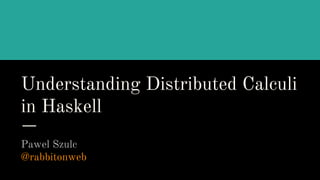



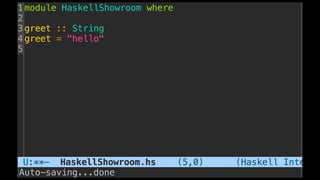


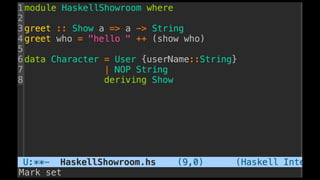

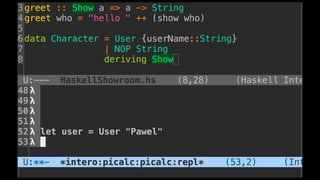





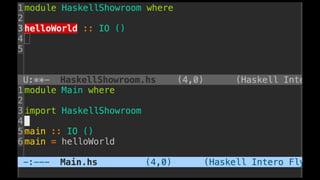






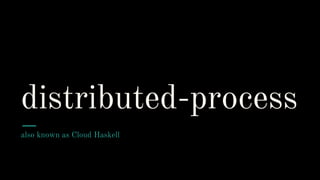
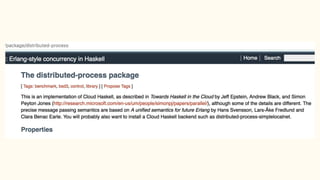










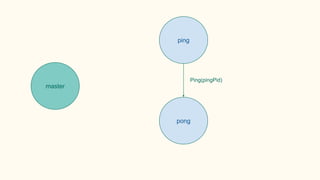
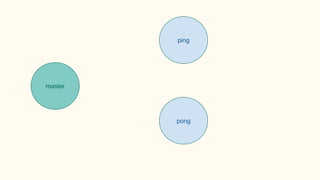
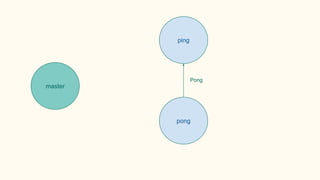






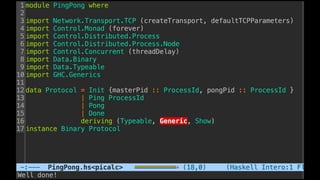












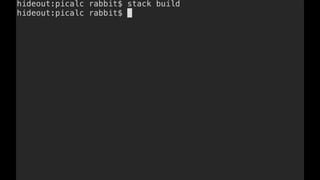










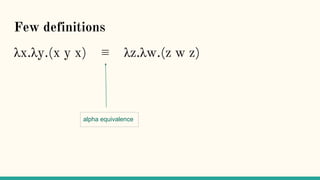










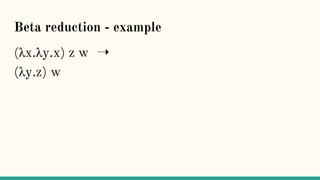








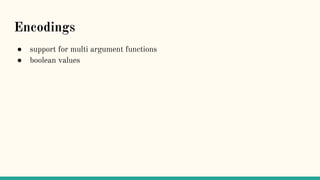




![Is there a calculus for distributed computing?
“The inevitability of the lambda-calculus arises
from the fact that the only way to observe a
functional computation is to watch which output
values it yields when presented with different
input values” [1]](https://image.slidesharecdn.com/understandingdistributedcalculiinhaskell-180304222304/85/Understanding-distributed-calculi-in-Haskell-97-320.jpg)
![Is there a calculus for distributed computing?
“Unfortunately, the world of concurrent
computation is not so orderly. Different notions of
what can be observed may be appropriate in
different circumstances, giving rise to different
definitions of when two concurrent systems have
‘the same behavior’ ” [1]](https://image.slidesharecdn.com/understandingdistributedcalculiinhaskell-180304222304/85/Understanding-distributed-calculi-in-Haskell-98-320.jpg)

![CCS & CSP
CCS - Calculus of Communicating Systems [3]
CSP - Communicating Sequential Processes [4]](https://image.slidesharecdn.com/understandingdistributedcalculiinhaskell-180304222304/85/Understanding-distributed-calculi-in-Haskell-100-320.jpg)

![What is π-calculus
“π -calculus is a model of computation for
concurrent systems.” [2]](https://image.slidesharecdn.com/understandingdistributedcalculiinhaskell-180304222304/85/Understanding-distributed-calculi-in-Haskell-102-320.jpg)
![What is π-calculus
“In lambda-calculus everything is a function (...)
In the pi-calculus every expression denotes a
process - a free-standing computational activity,
running in parallel with other process.” [1]](https://image.slidesharecdn.com/understandingdistributedcalculiinhaskell-180304222304/85/Understanding-distributed-calculi-in-Haskell-103-320.jpg)
![What is π-calculus
“Two processes can interact by exchanging a
message on a channel” [1]](https://image.slidesharecdn.com/understandingdistributedcalculiinhaskell-180304222304/85/Understanding-distributed-calculi-in-Haskell-104-320.jpg)
![What is π-calculus
“It lets you represent processes, parallel
composition of processes, synchronous
communication between processes through
channels, creation of fresh channels, replication of
processes, and nondeterminism.” [2]](https://image.slidesharecdn.com/understandingdistributedcalculiinhaskell-180304222304/85/Understanding-distributed-calculi-in-Haskell-105-320.jpg)



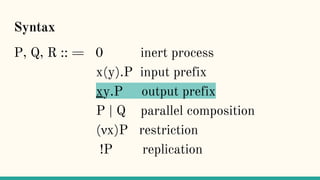











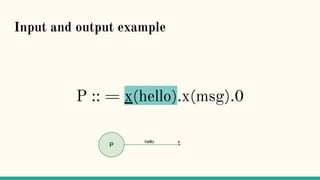














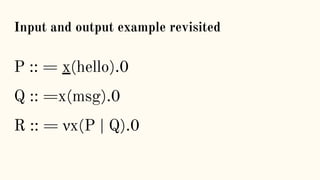




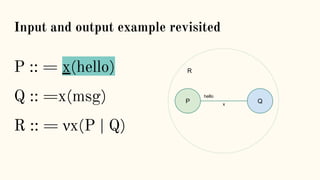
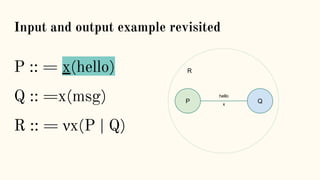
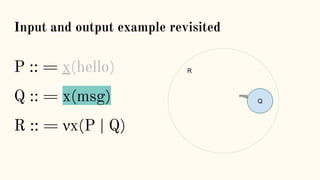




![Structural Congruence
“Two processes are structurally congruent, if they
are identical up to structure.” [5]](https://image.slidesharecdn.com/understandingdistributedcalculiinhaskell-180304222304/85/Understanding-distributed-calculi-in-Haskell-148-320.jpg)








![Reduction rules ⟶
xy.P | x(z).Q → P | [y/z]Q communication](https://image.slidesharecdn.com/understandingdistributedcalculiinhaskell-180304222304/85/Understanding-distributed-calculi-in-Haskell-157-320.jpg)
![Reduction rules ⟶
xy.P | x(z).Q → P | [y/z]Q communication
P | R → if P → Q reduction under |](https://image.slidesharecdn.com/understandingdistributedcalculiinhaskell-180304222304/85/Understanding-distributed-calculi-in-Haskell-158-320.jpg)
![Reduction rules ⟶
xy.P | x(z).Q → P | [y/z]Q communication
P | R → Q | R if P → Q reduction under |](https://image.slidesharecdn.com/understandingdistributedcalculiinhaskell-180304222304/85/Understanding-distributed-calculi-in-Haskell-159-320.jpg)
![Reduction rules ⟶
xy.P | x(z).Q → P | [y/z]Q communication
P | R → Q | R if P → Q reduction under |
(νx)P → if P → Q reduction under ν](https://image.slidesharecdn.com/understandingdistributedcalculiinhaskell-180304222304/85/Understanding-distributed-calculi-in-Haskell-160-320.jpg)
![Reduction rules ⟶
xy.P | x(z).Q → P | [y/z]Q communication
P | R → Q | R if P → Q reduction under |
(νx)P → (νx)Q if P → Q reduction under ν](https://image.slidesharecdn.com/understandingdistributedcalculiinhaskell-180304222304/85/Understanding-distributed-calculi-in-Haskell-161-320.jpg)
![Reduction rules ⟶
xy.P | x(z).Q → P | [y/z]Q communication
P | R → Q | R if P → Q reduction under |
(νx)P → (νx)Q if P → Q reduction under ν
P → if P ≡ P’ Q’ ≡ Q structural congruence](https://image.slidesharecdn.com/understandingdistributedcalculiinhaskell-180304222304/85/Understanding-distributed-calculi-in-Haskell-162-320.jpg)
![Reduction rules ⟶
xy.P | x(z).Q → P | [y/z]Q communication
P | R → Q | R if P → Q reduction under |
(νx)P → (νx)Q if P → Q reduction under ν
P → if P ≡ P’ → Q’ ≡ Q structural congruence](https://image.slidesharecdn.com/understandingdistributedcalculiinhaskell-180304222304/85/Understanding-distributed-calculi-in-Haskell-163-320.jpg)
![Reduction rules ⟶
xy.P | x(z).Q → P | [y/z]Q communication
P | R → Q | R if P → Q reduction under |
(νx)P → (νx)Q if P → Q reduction under ν
P → Q if P ≡ P’ → Q’ ≡ Q structural congruence](https://image.slidesharecdn.com/understandingdistributedcalculiinhaskell-180304222304/85/Understanding-distributed-calculi-in-Haskell-164-320.jpg)



![Some examples(1) - PingPong
P ::= x(ping).x(pong) | x(ping).x(pong)
xy.P | x(z).Q → P | [y/z]Q communication](https://image.slidesharecdn.com/understandingdistributedcalculiinhaskell-180304222304/85/Understanding-distributed-calculi-in-Haskell-168-320.jpg)
![Some examples(1) - PingPong
P ::= x(ping).x(pong) | x(ping).x(pong)
xy.P | x(z).Q → P | [y/z]Q communication](https://image.slidesharecdn.com/understandingdistributedcalculiinhaskell-180304222304/85/Understanding-distributed-calculi-in-Haskell-169-320.jpg)
![Some examples(1) - PingPong
P ::= x(ping).x(pong) | x(ping).x(pong)
xy.P | x(z).Q → P | [y/z]Q communication](https://image.slidesharecdn.com/understandingdistributedcalculiinhaskell-180304222304/85/Understanding-distributed-calculi-in-Haskell-170-320.jpg)
![Some examples(1) - PingPong
P ::= x(pong) | x(pong)
xy.P | x(z).Q → P | [y/z]Q communication](https://image.slidesharecdn.com/understandingdistributedcalculiinhaskell-180304222304/85/Understanding-distributed-calculi-in-Haskell-171-320.jpg)

![Some examples(1) - PingPong
P ::= x(pong) | x(pong)
xy.P | x(z).Q → P | [y/z]Q communication](https://image.slidesharecdn.com/understandingdistributedcalculiinhaskell-180304222304/85/Understanding-distributed-calculi-in-Haskell-173-320.jpg)
![Some examples(1) - PingPong
P ::= x(pong) | x(pong)
xy.P | x(z).Q → P | [y/z]Q communication](https://image.slidesharecdn.com/understandingdistributedcalculiinhaskell-180304222304/85/Understanding-distributed-calculi-in-Haskell-174-320.jpg)
![Some examples(1) - PingPong
P ::= 0 | 0
xy.P | x(z).Q → P | [y/z]Q communication](https://image.slidesharecdn.com/understandingdistributedcalculiinhaskell-180304222304/85/Understanding-distributed-calculi-in-Haskell-175-320.jpg)
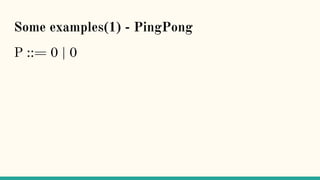
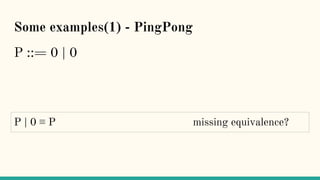





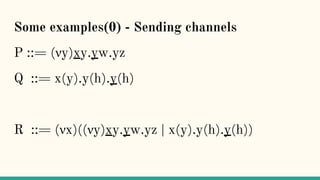
![Some examples(0) - Sending channels
P ::= (νy)xy.yw.yz
Q ::= x(y).y(h).y(h)
R ::= (νx)((νy)xy.yw.yz | x(y).y(h).y(h))
xy.P | x(z).Q → P | [y/z]Q communication](https://image.slidesharecdn.com/understandingdistributedcalculiinhaskell-180304222304/85/Understanding-distributed-calculi-in-Haskell-184-320.jpg)
![Some examples(0) - Sending channels
P ::= (νy)xy.yw.yz
Q ::= x(y).y(h).y(h)
R ::= (νx)((νy)xy.yw.yz | x(y).y(h).y(h))
xy.P | x(z).Q → P | [y/z]Q communication](https://image.slidesharecdn.com/understandingdistributedcalculiinhaskell-180304222304/85/Understanding-distributed-calculi-in-Haskell-185-320.jpg)
![Some examples(0) - Sending channels
P ::= (νy)xy.yw.yz
Q ::= x(y).y(h).y(h)
R ::= (νx)((νy)yw.yz | y(h).y(h))
xy.P | x(z).Q → P | [y/z]Q communication](https://image.slidesharecdn.com/understandingdistributedcalculiinhaskell-180304222304/85/Understanding-distributed-calculi-in-Haskell-186-320.jpg)
![Some examples(0) - Sending channels
P ::= (νy)xy.yw.yz
Q ::= x(y).y(h).y(h)
R ::= (νx)((νy)yw.yz | y(h).y(h))
xy.P | x(z).Q → P | [y/z]Q communication](https://image.slidesharecdn.com/understandingdistributedcalculiinhaskell-180304222304/85/Understanding-distributed-calculi-in-Haskell-187-320.jpg)
![Some examples(0) - Sending channels
P ::= (νy)xy.yw.yz
Q ::= x(y).y(h).y(h)
R ::= (νx)((νy)yz | y(h))
xy.P | x(z).Q → P | [y/z]Q communication](https://image.slidesharecdn.com/understandingdistributedcalculiinhaskell-180304222304/85/Understanding-distributed-calculi-in-Haskell-188-320.jpg)





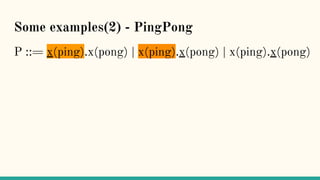


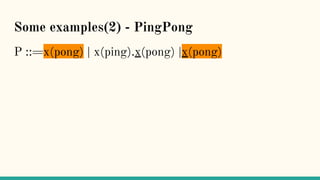












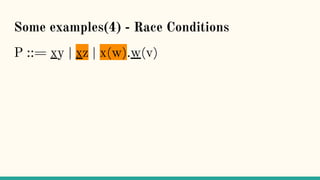
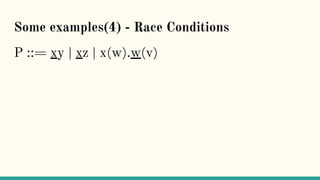



![Two processes P and Q are bisimilar if ...
“Two processes P and Q are bisimilar if every
action of one can be matched by a corresponding
action of the other to reach bisimilar state” [1]](https://image.slidesharecdn.com/understandingdistributedcalculiinhaskell-180304222304/85/Understanding-distributed-calculi-in-Haskell-215-320.jpg)







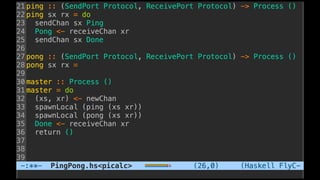

![Implementation issue...
“This seems quite natural.(...).But there’s a big problem here.
ReceivePorts are not Serializable, which prevents us passing
the ReceivePort r1 to the spawned process. GHC will reject the
program with a type error.” [8]](https://image.slidesharecdn.com/understandingdistributedcalculiinhaskell-180304222304/85/Understanding-distributed-calculi-in-Haskell-225-320.jpg)
![Implementation issue...
“Why are ReceivePorts not Serializable? If you think about it a
bit, this makes a lot of sense. If a process were allowed to send
a ReceivePort somewhere else, the implementation would have
to deal with two things: routing messages to the correct desti‐
nation when a ReceivePort has been forwarded (possibly
multiple times), and routing messages to multiple destinations,
because sending a ReceivePort would create a new copy.” [8]](https://image.slidesharecdn.com/understandingdistributedcalculiinhaskell-180304222304/85/Understanding-distributed-calculi-in-Haskell-226-320.jpg)
![Implementation issue...
“This would introduce a vast amount of complexity to the
implementation, and it is not at all clear that it is a good feature
to allow. So the remote framework explicitly disallows it,
which fortunately can be done using Haskell’s type system.”
[8]](https://image.slidesharecdn.com/understandingdistributedcalculiinhaskell-180304222304/85/Understanding-distributed-calculi-in-Haskell-227-320.jpg)




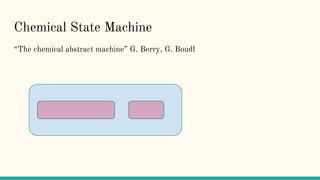




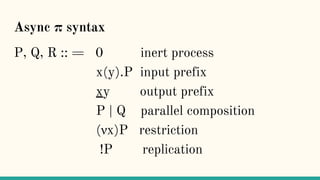



![ρ-calculus
“The π-calculus is not a closed theory, but rather
a theory dependent upon some theory of names.
(...) names may be tcp/ip ports or urls or object
references, etc. But, foundationally, one might ask
if there is a closed theory of processes, i.e. one in
which the theory of names arises from and is
wholly determined by the theory of processes.” [7]](https://image.slidesharecdn.com/understandingdistributedcalculiinhaskell-180304222304/85/Understanding-distributed-calculi-in-Haskell-241-320.jpg)
![Quoting
“Here we present a theory of an asynchronous
message-passing calculus built on a notion of
quoting. Names are quoted processes, and as such
represent the code of a process.(...) Name-passing,
then becomes a way of passing the code of a
process as a message.” [7]](https://image.slidesharecdn.com/understandingdistributedcalculiinhaskell-180304222304/85/Understanding-distributed-calculi-in-Haskell-242-320.jpg)




![x⦉P⦊
“Process P will be packaged up as its code, ⌜P⌝,
and ultimately made available as an output at the
port x” [7]](https://image.slidesharecdn.com/understandingdistributedcalculiinhaskell-180304222304/85/Understanding-distributed-calculi-in-Haskell-247-320.jpg)
![x⦉P⦊
“Process P will be packaged up as its code, ⌜P⌝,
and ultimately made available as an output at the
port x” [7]
“The lift operator turns out to play a role
analogous to (νx)”](https://image.slidesharecdn.com/understandingdistributedcalculiinhaskell-180304222304/85/Understanding-distributed-calculi-in-Haskell-248-320.jpg)


![⌝x⌜
“The ⌝x⌜ operator (...) eventually extracts the
process from a name. We say ‘eventually’ because
this extraction only happens when quoted process
is substituted into this expression.” [7]](https://image.slidesharecdn.com/understandingdistributedcalculiinhaskell-180304222304/85/Understanding-distributed-calculi-in-Haskell-251-320.jpg)
![⌝x⌜
“A consequence of this behaviour is that the ⌝x⌜ is
inert, except under an input prefix” [7]](https://image.slidesharecdn.com/understandingdistributedcalculiinhaskell-180304222304/85/Understanding-distributed-calculi-in-Haskell-252-320.jpg)















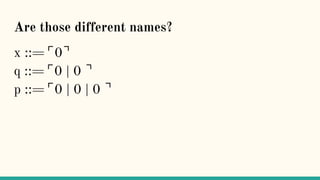
![Are those different names?
“This question leads to several intriguing and
apparently fundamental questions. Firstly, if
names have structure, what is a reasonable notion
of equality on names? How much computation, and
of what kind, should go into ascertaining equality
on names?” [7]](https://image.slidesharecdn.com/understandingdistributedcalculiinhaskell-180304222304/85/Understanding-distributed-calculi-in-Haskell-269-320.jpg)






